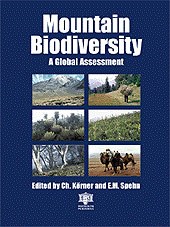Mountain biodiversity: a global assessment
| Year of publication | 2002 |
|---|---|
| Co-authors | Eva Spehn |
| Publisher(s) | Botanisches Institut Christian Körner Website: http://pages.unibas.ch/botschoen/koerner/i... |
| Publisher | Parthenon Publishing at CRC Press |
| Place of publication | London |
| ISBN/ISSN | 84214-091-4 |
| Language | en |
| Price | £62.99, $89.95 |
| Purchase | http://www.unibas.ch/gmba/leaflet.pdf |
This book is a contribution to the International Year of the Mountains. It brings together knowledge from around the world, gathered from contributions to the first international conference on mountain biodiversity, its function and change, and is part of the Global Mountain Biodiversity Assessment (GMBA).
Mountain biodiversity is perhaps the best indicator of the integrity of mountain ecosystems. More than 50% of the world's population depends directly or indirectly on mountain resources and services, such as water supply, and thus on the integrity of these upland ecosystems. Steep terrain, climate, and severe land-use pressure make mountain ecosystems among the world's most endangered landscapes.
The 28 chapters in this book represent research on the biological riches in all major mountain ranges of the world, and synthesize existing knowledge on mountain biodiversity - from diversity of bacteria, plants and animals to human diversity. The book is divided into five sections: an introduction providing an overview of the issues; plant and animal diversity; climate change and mountain biodiversity; land use and conservation; and a synthesis.
Source: http://www.unibas.ch/gmba/leaflet.pdf
Mountain biodiversity is perhaps the best indicator of the integrity of mountain ecosystems. More than 50% of the world's population depends directly or indirectly on mountain resources and services, such as water supply, and thus on the integrity of these upland ecosystems. Steep terrain, climate, and severe land-use pressure make mountain ecosystems among the world's most endangered landscapes.
The 28 chapters in this book represent research on the biological riches in all major mountain ranges of the world, and synthesize existing knowledge on mountain biodiversity - from diversity of bacteria, plants and animals to human diversity. The book is divided into five sections: an introduction providing an overview of the issues; plant and animal diversity; climate change and mountain biodiversity; land use and conservation; and a synthesis.
Source: http://www.unibas.ch/gmba/leaflet.pdf
